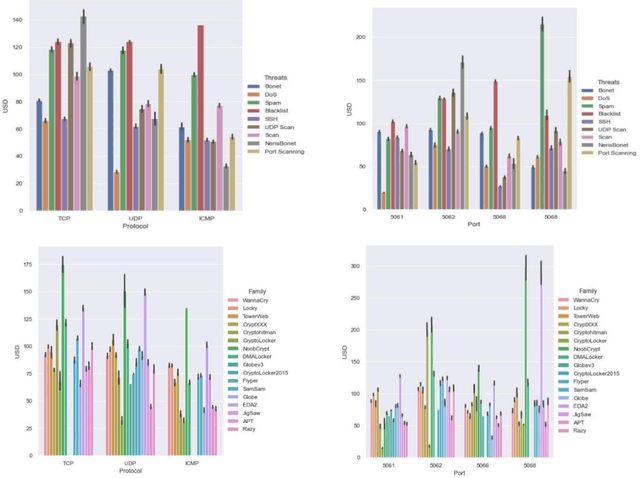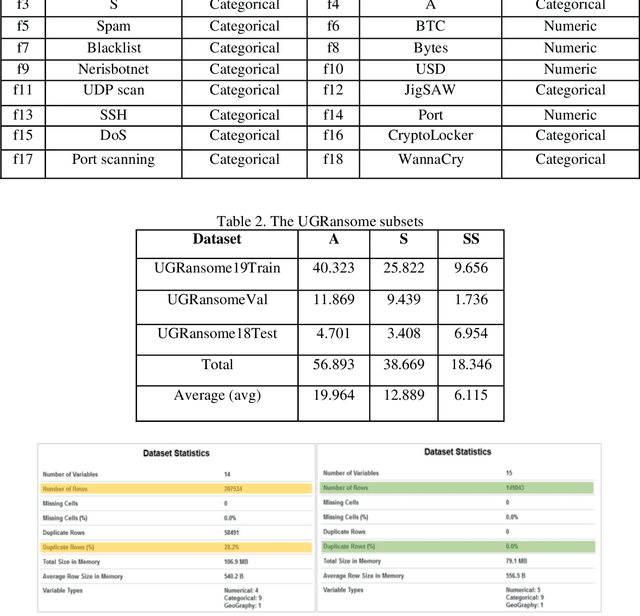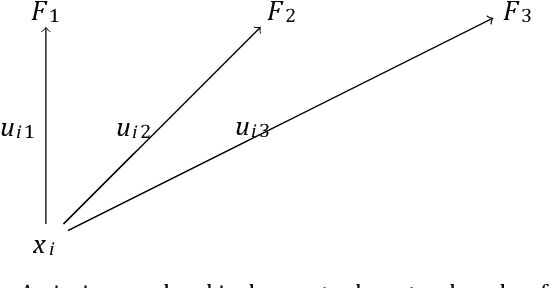Mike Nkongolo
Ransomware detection using stacked autoencoder for feature selection
Feb 17, 2024



Abstract:The aim of this study is to propose and evaluate an advanced ransomware detection and classification method that combines a Stacked Autoencoder (SAE) for precise feature selection with a Long Short Term Memory (LSTM) classifier to enhance ransomware stratification accuracy. The proposed approach involves thorough pre processing of the UGRansome dataset and training an unsupervised SAE for optimal feature selection or fine tuning via supervised learning to elevate the LSTM model's classification capabilities. The study meticulously analyzes the autoencoder's learned weights and activations to identify essential features for distinguishing ransomware families from other malware and creates a streamlined feature set for precise classification. Extensive experiments, including up to 400 epochs and varying learning rates, are conducted to optimize the model's performance. The results demonstrate the outstanding performance of the SAE-LSTM model across all ransomware families, boasting high precision, recall, and F1 score values that underscore its robust classification capabilities. Furthermore, balanced average scores affirm the proposed model's ability to generalize effectively across various malware types. The proposed model achieves an exceptional 99% accuracy in ransomware classification, surpassing the Extreme Gradient Boosting (XGBoost) algorithm primarily due to its effective SAE feature selection mechanism. The model also demonstrates outstanding performance in identifying signature attacks, achieving a 98% accuracy rate.
Enhancing search engine precision and user experience through sentiment-based polysemy resolution
Nov 03, 2023



Abstract:With the proliferation of digital content and the need for efficient information retrieval, this study's insights can be applied to various domains, including news services, e-commerce, and digital marketing, to provide users with more meaningful and tailored experiences. The study addresses the common problem of polysemy in search engines, where the same keyword may have multiple meanings. It proposes a solution to this issue by embedding a smart search function into the search engine, which can differentiate between different meanings based on sentiment. The study leverages sentiment analysis, a powerful natural language processing (NLP) technique, to classify and categorize news articles based on their emotional tone. This can provide more insightful and nuanced search results. The article reports an impressive accuracy rate of 85% for the proposed smart search function, which outperforms conventional search engines. This indicates the effectiveness of the sentiment-based approach. The research explores multiple sentiment analysis models, including Sentistrength and Valence Aware Dictionary for Sentiment Reasoning (VADER), to determine the best-performing approach. The findings can be applied to enhance search engines, making them more capable of understanding the context and intent behind users 'queries. This can lead to better search results that are more aligned with what users are looking for. The proposed smart search function can improve the user experience by reducing the need to sift through irrelevant search results. This is particularly important in an age where information overload is common.
Stacking an autoencoder for feature selection of zero-day threats
Nov 01, 2023



Abstract:Zero-day attack detection plays a critical role in mitigating risks, protecting assets, and staying ahead in the evolving threat landscape. This study explores the application of stacked autoencoder (SAE), a type of artificial neural network, for feature selection and zero-day threat classification using a Long Short-Term Memory (LSTM) scheme. The process involves preprocessing the UGRansome dataset and training an unsupervised SAE for feature extraction. Finetuning with supervised learning is then performed to enhance the discriminative capabilities of this model. The learned weights and activations of the autoencoder are analyzed to identify the most important features for discriminating between zero-day threats and normal system behavior. These selected features form a reduced feature set that enables accurate classification. The results indicate that the SAE-LSTM performs well across all three attack categories by showcasing high precision, recall, and F1 score values, emphasizing the model's strong predictive capabilities in identifying various types of zero-day attacks. Additionally, the balanced average scores of the SAE-LSTM suggest that the model generalizes effectively and consistently across different attack categories.
Assessing Cyclostationary Malware Detection via Feature Selection and Classification
Aug 29, 2023Abstract:Cyclostationarity involves periodic statistical variations in signals and processes, commonly used in signal analysis and network security. In the context of attacks, cyclostationarity helps detect malicious behaviors within network traffic, such as traffic patterns in Distributed Denial of Service (DDoS) attacks or hidden communication channels in malware. This approach enhances security by identifying abnormal patterns and informing Network Intrusion Detection Systems (NIDSs) to recognize potential attacks, enhancing protection against both known and novel threats. This research focuses on identifying cyclostationary malware behavior and its detection. The main goal is to pinpoint essential cyclostationary features used in NIDSs. These features are extracted using algorithms such as Boruta and Principal Component Analysis (PCA), and then categorized to find the most significant cyclostationary patterns. The aim of this article is to reveal periodically changing malware behaviors through cyclostationarity. The study highlights the importance of spotting cyclostationary malware in NIDSs by using established datasets like KDD99, NSL-KDD, and the UGRansome dataset. The UGRansome dataset is designed for anomaly detection research and includes both normal and abnormal network threat categories of zero-day attacks. A comparison is made using the Random Forest (RF) and Support Vector Machine (SVM) algorithms, while also evaluating the effectiveness of Boruta and PCA. The findings show that PCA is more promising than using Boruta alone for extracting cyclostationary network feature patterns. Additionally, the analysis identifies the internet protocol as the most noticeable cyclostationary feature pattern used by malware. Notably, the UGRansome dataset outperforms the KDD99 and NSL-KDD, achieving 99% accuracy in signature malware detection using the RF algorithm and 98% with the SVM.
Fuzzification-based Feature Selection for Enhanced Website Content Encryption
Jun 23, 2023
Abstract:We propose a novel approach that utilizes fuzzification theory to perform feature selection on website content for encryption purposes. Our objective is to identify and select the most relevant features from the website by harnessing the principles of fuzzy logic. Fuzzification allows us to transform the crisp website content into fuzzy representations, enabling a more nuanced analysis of their characteristics. By considering the degree of membership of each feature in different fuzzy categories, we can evaluate their importance and relevance for encryption. This approach enables us to prioritize and focus on the features that exhibit higher membership degrees, indicating their significance in the encryption process. By employing fuzzification-based feature selection, we aim to enhance the effectiveness and efficiency of website content encryption, ultimately improving the overall internet security.
Smart Sentiment Analysis-based Search Engine Classification Intelligence
Jun 16, 2023



Abstract:Search engines are widely used for finding information on the internet. However, there are limitations in the current search approach, such as providing popular but not necessarily relevant results. This research addresses the issue of polysemy in search results by implementing a search function that determines the sentimentality of the retrieved information. The study utilizes a web crawler to collect data from the British Broadcasting Corporation (BBC) news site, and the sentimentality of the news articles is determined using the Sentistrength program. The results demonstrate that the proposed search function improves recall value while accurately retrieving nonpolysemous news. Furthermore, Sentistrength outperforms deep learning and clustering methods in classifying search results. The methodology presented in this article can be applied to analyze the sentimentality and reputation of entities on the internet.
Fuzzy Feature Selection with Key-based Cryptographic Transformations
Jun 16, 2023



Abstract:In the field of cryptography, the selection of relevant features plays a crucial role in enhancing the security and efficiency of cryptographic algorithms. This paper presents a novel approach of applying fuzzy feature selection to key-based cryptographic transformations. The proposed fuzzy feature selection leverages the power of fuzzy logic to identify and select optimal subsets of features that contribute most effectively to the cryptographic transformation process. By incorporating fuzzy feature selection into key-based cryptographic transformations, this research aims to improve the resistance against attacks and enhance the overall performance of cryptographic systems. Experimental evaluations may demonstrate the effectiveness of the proposed approach in selecting secure key features with minimal computational overhead. This paper highlights the potential of fuzzy feature selection as a valuable tool in the design and optimization of key-based cryptographic algorithms, contributing to the advancement of secure information exchange and communication in various domains.
 Add to Chrome
Add to Chrome Add to Firefox
Add to Firefox Add to Edge
Add to Edge